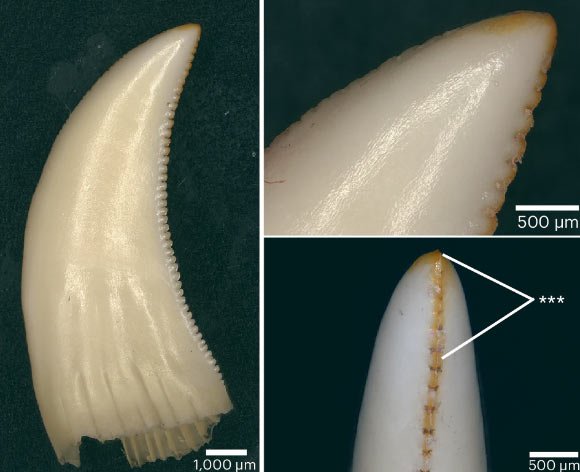Komodo Dragons Have Iron-Coated Teeth, New Study Reveals Hidden Weapon of Nature’s Top Predator…read more…
In a discovery that has stunned scientists and reptile enthusiasts alike, a new study has revealed that Komodo dragons—the world’s largest living lizards—possess iron-coated teeth, an evolutionary trait that gives their deadly bite an even more formidable edge.
Published this week in the Journal of Morphological Sciences, the groundbreaking research highlights a previously unknown feature of the Komodo dragon’s dentition. According to researchers from the University of Queensland and the Indonesian Institute of Sciences, microscopic analysis has shown that the dragon’s serrated teeth are coated in layers of iron-rich compounds, enhancing both their sharpness and durability.
A Biological Marvel
Komodo dragons (Varanus komodoensis), native to a handful of Indonesian islands, have long fascinated biologists. Known for their massive size—they can grow up to 10 feet long and weigh over 150 pounds—they are apex predators capable of taking down prey as large as deer and water buffalo. Their success as hunters is often attributed to their stealth, strength, and venomous saliva. But the latest findings add a new, metallic twist to their lethal arsenal.
“Through high-resolution electron microscopy, we discovered traces of iron embedded in the enamel of their teeth,” said lead author Dr. Natalie Greaves, a zoologist at the University of Queensland. “This iron coating likely plays a significant role in reducing tooth wear and increasing cutting efficiency.”
How Iron Enhances the Bite
The research team believes the iron acts similarly to how it does in man-made tools. By reinforcing the serrated edges of the Komodo’s teeth, it helps them slice through muscle and hide more effectively, with less risk of blunting or breakage. The teeth themselves are recurved and deeply serrated, optimized for pulling chunks of flesh from struggling prey.
Dr. Greaves likened the design to “a set of steak knives dipped in armor,” noting that this might explain why Komodos can consume nearly their body weight in a single feeding and often kill with just one bite.
The presence of iron was detected using a combination of energy-dispersive X-ray spectroscopy and elemental mapping techniques, which allowed the researchers to identify metallic compounds within the outer layer of the teeth. These findings suggest that the iron is not just absorbed from the environment but is biologically deposited during tooth formation.
Evolutionary Implications
The discovery also raises intriguing questions about the evolutionary trajectory of the species. Iron is not commonly found in the teeth of reptiles or mammals. While many animals possess specialized teeth—such as the self-sharpening molars of rodents or the serrated fangs of snakes—iron-enriched enamel is rare.
“This adaptation could reflect the harsh conditions of their natural environment,” explained Dr. Arif Pratama, co-author and evolutionary biologist based in Jakarta. “Komodo dragons often go weeks without food, so when they do eat, they must maximize efficiency. Iron-coated teeth help ensure that every bite counts.”
It’s still unclear how Komodo dragons manage to incorporate iron into their enamel. Some scientists hypothesize it may be linked to their diet, which includes carrion and iron-rich blood from prey. Others suggest it could be a genetically coded trait, evolved over millennia.
More Than Just Bite: What This Means for Conservation
Komodo dragons are classified as endangered by the International Union for Conservation of Nature (IUCN), with fewer than 6,000 individuals left in the wild. Habitat loss, human encroachment, and climate change continue to threaten their survival. Yet, discoveries like this offer hope that a deeper understanding of their biology can support more effective conservation strategies.
“Knowing how their bodies function at a microscopic level helps us better understand their health and resilience,” said Dr. Pratama. “It could even lead to new medical or material innovations based on biomimicry.”
Indeed, materials scientists have already expressed interest in exploring whether the iron-coating mechanism of Komodo dragon teeth could inspire new kinds of surgical tools or wear-resistant blades. “Nature has had millions of years to perfect these designs,” remarked Dr. Lynn Howard, a materials expert not involved in the study. “There’s a lot we can learn by paying attention.”
A Predator Like No Other
Komodo dragons are often described as “living dinosaurs,” and this new discovery only reinforces that reputation. Their terrifying bite, already capable of causing fatal wounds laced with bacteria and venom, now appears to be even deadlier than previously thought.
The researchers hope to expand their study to include other monitor lizard species to determine whether the iron-coating phenomenon is unique to Komodo dragons or part of a broader evolutionary pattern among carnivorous reptiles. They also plan to explore whether age, diet, or sex influence the degree of iron enrichment in the teeth.
“For such a well-known animal, it’s astonishing that we’re still uncovering fundamental aspects of its biology,” Dr. Greaves said. “It’s a reminder of how much we still don’t know—and how much there still is to discover.”
Public Fascination Grows
News of the discovery has sparked interest well beyond the scientific community. Social media users have marveled at the idea of dragons with metal-infused teeth, with some joking that Komodos are “basically medieval weapons with legs.” Wildlife documentaries and science channels are already planning segments around the discovery, and the Indonesian government has expressed renewed interest in promoting the Komodo National Park as a site of global ecological importance.
As the science unfolds, one thing remains clear: Komodo dragons are not just remnants of an ancient past—they are cutting-edge examples of evolutionary innovation. Their iron-coated teeth are a striking testament to nature’s ingenuity, offering new insight into how apex predators thrive, adapt, and continue to astonish us.
Whether through conservation, scientific research, or sheer fascination, the Komodo dragon’s fearsome
legacy seems set to endure for generations to come.



